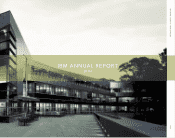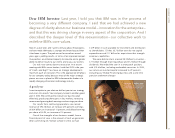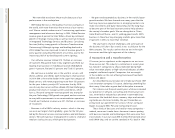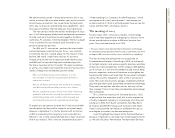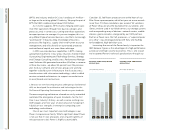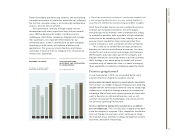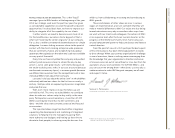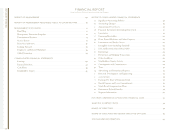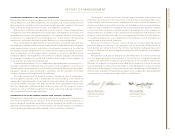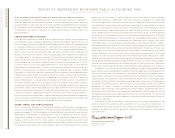IBM 2004 Annual Report Download - page 4
Download and view the complete annual report
Please find page 4 of the 2004 IBM annual report below. You can navigate through the pages in the report by either clicking on the pages listed below, or by using the keyword search tool below to find specific information within the annual report.
02
chairman’s letter
We were able to achieve these results because of our
performance in the marketplace.
•IBM Global Services is the leading IT services company in
the world, with more than twice the revenue of our nearest
rival. We are ranked number one in IT outsourcing, application
management and e-business hosting. In 2004, Global Services
revenue grew 8percent to $46.2 billion, driven by continued
growth in Strategic Outsourcing, as well as revenue increases
in Integrated Technology Services and Business Consulting
Services (led by strong growth in Business Transformation
Outsourcing). Although signings and backlog declined in
2004, Global Services improved its rate of revenue growth in
every quarter, excluding the benefit of currency, due to the
improving yield of our backlog and current signings.
•Our software revenue totaled $15.1 billion, an increase
of 5percent. We gained share in key segments and held our
leading share position in middleware overall. WebSphere
grew 14 percent, Rational 15 percent and Tivoli 15 percent.
•We continue as number one in the world in servers, with
zSeries, pSeries and xSeries each increasing its share position
in 2004.IBM is the market leader in the super-hot category of
blade servers, with revenue growing more than 150 percent
for the year. Industry analyst IDC estimates that by 2008
one of every four servers will be a blade. We had challenging
product transitions in storage systems and iSeries, which
hurt us. Personal computer revenue growth was strong for
the year. Technology OEM growth was good, and we continue
to see yield improvements in our semiconductor operation.
Overall, our hardware revenue was $31.2 billion, an increase
of 10 percent.
•Revenue in all of IBM’s industry sectors— which is the way
we serve our largest clients globally—grew for the full year,
led by the financial services, communications and distribution
sectors. We continued our strong growth in sales to small and
medium-size businesses, which grew by 8percent.
•We grew and expanded our business in the world’s hyper-
growth markets. We have learned over many years that the
best way to pursue opportunities in emerging markets is to
make investments and build relationships for the long haul,
to become part of the local economy and to help advance
the society’s broader goals. We are doing that in China,
India, Brazil and Russia— and it’s yielding good results. IBM’s
business in these four key emerging markets grew more than
25 percent in 2004, to more than $4billion.
The year had its share of challenges, and some parts of
the business fell short. But overall, it was a solid year for the
IBM company. The results confirm that we are in the right
businesses and the right segments of the industry.
A transaction and a transformation
Of course, just as significant as the segments we are in are
those we are not. The industry’s contraction in recent years
has forced IT companies to choose between being high-
value innovation players or high-volume distributors of other
people’s intellectual capital. Companies that are caught
in the middle run the risk of being hammered from both
below and above.
As I described to you last year, we’ve made our choice: IBM
is an innovation company. Of course, declaring something like
that is easy. It has taken a great deal of discipline to execute.
For instance, over the past several years, while we increased
our presence in software, consulting and infrastructure serv-
ices, we exited or reduced our presence in commoditizing
businesses like hard disk drives, memory chips and network-
ing hardware. And most notably, this past December we
announced our agreement for Lenovo, China’s computer
leader, to acquire IBM’s Personal Computing Division.
These kinds of decisions are hard for many companies—
indeed, some won’t make them—because it means parting
with business models and technologies that were once their
crown jewels. In our own case, IBM invented the hard disk drive
and DRAM chip, and we set the standard in PCs back in 1981.

